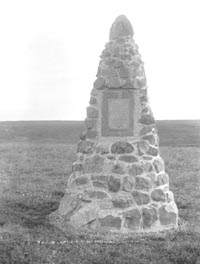Extract from the pages of the Muirkirk Advertiser 1914
On Saturday afternoon last (18th July, 1914), several of the members of the Lapraik Burns Club journeyed per brake to Dalfram, the object being to visit the monumental cairn lately erected to the memory of the Poet, John Lapraik, and to formerly inaugurate the same.
 The President of the Club, Mr
Archibald Fairbairn, gave an admirable address, in which he summarised the work done during the past two years, which had resulted in the formation of the cairn, and incidentally
remarked that both it and the ground on which it was built was now the property of the Club. In a sense it was a classic soil, for it was certain that on a little hill nearby stood the dwelling
place of Lapraik. Here, amongst other stanes, lime, and debris were found Lapraik's hearthstone and other things which only belong to a dwelling house.
The President of the Club, Mr
Archibald Fairbairn, gave an admirable address, in which he summarised the work done during the past two years, which had resulted in the formation of the cairn, and incidentally
remarked that both it and the ground on which it was built was now the property of the Club. In a sense it was a classic soil, for it was certain that on a little hill nearby stood the dwelling
place of Lapraik. Here, amongst other stanes, lime, and debris were found Lapraik's hearthstone and other things which only belong to a dwelling house.
Mr Fairbairn then explained all about the building of the cairn, which is over 11 feet in height, and built chiefly from the stones derived from the site of
Lapraik's house. Amongst those of the members who had taken a practical interest in the building, he could easily single out Mr Thomas Weir, who was responsible for the plans
adopted to keep all safe in the jar built into the cairn, and he expected Mr Weir's plan would be effectual.
In the jar there were the following:
(1) History of the Lapraik Burns Club, No. 56 of the Burns Federation, by the Secretary, Mr Hugh Bell.
(2) Two "Muirkirk Advertisers."
(3) Abstracts of the Parish Council and School Board for 13-14.
(4) Two of the Club's Greetings, 1904, 1914.
(5) A piece of wood from the Auld Brig of Ayr, from James Clark, Esq., Crossflatt.
(6) "Muirkirk in Bygone Days," by J. G. A. Baird, Esq., of Wellwood.
Mr Thomas Weir, the father and poet laureate of the Club, expressed great pleasure in being there, where, 129 years ago, honest-hearted auld Lapraik had his home. Mr Weir repeated all the epistles betwixt Burns and Lapraik in his own surpassing style, and referred to the meeting of the poets, probably in 1785. Our poet was the oldest in the list of the contemporaries of Burns, and was much loved by the National Poet for his sterling qualities.
He was indeed Burns' model in "A Man's a Man for a' That."
Mr C. Bell traced in pretty full detail the history of the Lapraik family since La Privic (according to tradition a Frenchman who had come in Queen Mary's retinue to Leith and Edinburgh in 1561), bought Dalfram.
His great grandson,the "sclandered man," is mentioned in "Muirkirk in Bygone Days" as living in 1661. His son again and the father of the poet is also mentioned there in connection with the Session's minutes of 1704.
The poet was born in 1727, and died in 1807. Mr Bell, in connection with the poet and Burns, mentioned about the Post Office, the mail route at the time to Douglas Mill, Lapraik's son who was a farmer in Darnhunch, and another son of the poet, "Cooper Lapraik," who was seized by the British Press Gang at Troon and was long a prisoner in France.
The farmer in Darnhunch had a son whom many still remembered. He was known to the older generation as "Baker Lapraik," and the latter had also a son, who may yet be alive. If so, he is the great grandson of the poet. Certain it is descendants in the female line still reside in Ayrshire.
Mr Pringle briefly described the formation of the Lapraik Burns Club 21 years ago, and ran its history up to date.
 At a convenient
height on the cairn is fixed a brass tablet upon which the following is neatly inscribed inside a neat border, the two top pieces being each formed by a Scots thistle,
while the plough occupies a prominent position at the bottom of the inscription:-
At a convenient
height on the cairn is fixed a brass tablet upon which the following is neatly inscribed inside a neat border, the two top pieces being each formed by a Scots thistle,
while the plough occupies a prominent position at the bottom of the inscription:-
"This cairn was erected A.D. 1914, by the Lapraik Burns Club of Muirkirk, to mark the spot where stood the house of "Bauld Lapraik" the friend of the Poet, Robert Burns.
But if the beast and branks be spar'd
Till kye gaun without the herd,
An' a' the vittal in the yard,
An' theekit right,
I mean your ingle-side to guard
Ae winter night."